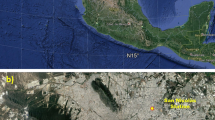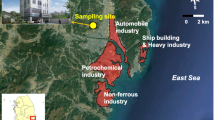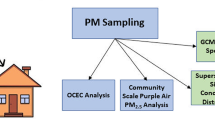Abstract
Accurate characterization of the chemical composition of particulate matter (PM) is essential for improved understanding of source attribution and resultant health impacts. To explore this, we conducted ambient monitoring of a suite of 15 combustion-related organic species in temporally resolved PM2.5 samples during an ongoing animal exposure study in a near source environment in Detroit, MI. All of the 15 species detected were above the method detection limit in 8 h samples. This study focused on two molecular classes: polycyclic aromatic hydrocarbons (PAHs) and hopanes measured in samples. Of the 12 PAHs studied, benzo[b]fluoranthene (169 pg m−3), benzo[g,h,i]perylene (124 pg m−3), and benzo[e]pyrene (118 pg m−3) exhibited the three highest mean concentrations while 17α(H),21β(H)-hopane (189 pg m−3) and 17α(H),21β(H)-30-norhopane (145 pg m−3) had the highest mean concentrations of the three hopanes analyzed in samples. Ratios of individual compound concentrations to total compound concentrations (∑15 compounds) showed the greatest daily variation for 17α(H),21β(H)-hopane (11–28%) and 17α(H),21β(H)-30-norhopane (8–20%). Diagnostic PAH concentration ratios ([IP]/[IP + BP] (range 0.30–0.45), [BaP]/[BaP + BeP] (range 0.26–0.44), [BaP]/[BP] (range 0.41–0.82), [Bb]/[Bk] (range 2.07–2.66)) in samples reflected impacts from a mixture of combustion sources consistent with greater prevalence of petroleum combustion source emissions (gasoline, diesel, kerosene, and crude oil) compared to coal or wood combustion emissions impacts at this urban site. Results from this study demonstrate that short-duration sampling for organic speciation provides temporally relevant exposure information.



Similar content being viewed by others
References
Bi X, Simoneit BRT, Sheng G, Ma S, Xinhui JF, Fu J (2008) Composition and major sources of organic compounds in urban aerosols. Atmos Res 88:256–265
Boucher O, Randall D, Artaxo P, Bretherton C, Feingold G, Forster P, Kerminen V-M, Kondo Y, Liao H, Lohmann U, Rasch P, Satheesh SK, Sherwood S, Stevens B, Zhang XY (2013) Clouds and aerosols, In: Climate change, : the physical science basis. Contribution of Working Group I to the Fifth Assessment Report of the Intergovernmental Panel on Climate Change. Cambridge University Press, United Kingdom and New York, pp 571–657
Chow JC, Lowenthal DH, Antony Chen LW, Wang X, Wayson JG (2015) Mass reconstruction methods for PM2.5: a review. Air Qual Atmos Health 8:243–263
Downard J, Singh A, Bullard R, Jayarathne T, Rathnayake CM, Simmons DL, Wels BR, Spak SN, Peters T, Beardsley D, Stanier CO, Stone EA (2015) Uncontrolled combustion of shredded tires in a landfill e part 1: characterization of gaseous and particulate emissions. Atmos Env 104:195–204
Gildemeister AE, Hopke P, Kim E (2007) Sources of fine urban particulate matter in Detroit, MI. Chemosphere 69:1064–1074
Giri B, Patel KS, Jaiswal NK, Sharma S, Ambade B, Wang W, Massey Simonich SL, Simoneit BRT (2013) Composition and sources of organic tracers in aerosol particles of industrial central India. Atmos Res 120–121:312–324
Gogou A, Strarigakis N, Kanakido M, Stephanou EG (1996) Organic aerosols in the Eastern Mediterranean: components source reconciliation by using molecular markers and atmospheric back trajectories. Org Geochem 1:79–96
Górka M, Rybicki M, Simoneit BRT, Marynowski L (2014) Determination of multiple organic matter sources in aerosol PM10 from Wroclaw, Poland using molecular and stable carbon isotope compositions. Atmos Env 89:739–748
Greenwald R, Bergin MH, Yip FY, Boehner T, Kewada P, Shafer M, Schauer JJ, Sarnat JA (2014) On-roadway in-cabin exposure to particulate matter: measurement results using both continuous and time-integrated sampling approaches. Aerosol Sci Technol 48:664–675
Hammond DM, Dvonch JT, Keeler GJ, Parker EA, Kamal AS, Barres JA, Yip FY, Brakefield-Caldwell W (2008) Sources of ambient fine particulate matter at two community sites in Detroit. MI Atmos Env 42:720–732
He LY, Hu M, Zhang YH, Huang XF, Yao TT (2008) Fine particle emissions from on road vehicles in the Zhujiang Tunnel, China. Environ Sci Technol 42:4461–4466
Heo J, Dulger M, Olson MR, McGinnis JE, Shelton BR, Matsunaga A, Sioutas C, Schauer JJ (2013) Source apportionments of PM2.5 organic carbon using molecular marker positive matrix factorization and comparison of results from different receptor models. Atmos Env 73:51–61
Katsoyiannis A, Sweetman AJ, Jones KC (2011) PAH molecular diagnostic ratios applied to atmospheric sources: a critical evaluation using two decades of source inventory and air concentration data from the UK. Env Sci Technol 45:8897–8906
Křůmal K, Mikuška P, Večeřa Z (2013) Polycyclic aromatic hydrocarbons and hopanes in PM1 aerosols un urban areas. Atmos Environ 67:27–37
Landis MS, Lewis CW, Stevens RK, Keeler GJ, Dvonch JT, Tremblay R (2007) Ft. McHenry tunnel study: source profiles and mercury emissions from diesel and gasoline powered vehicles. Atmos Environ 41:8711–8724
Larson S, Cass GR, Gray HA (1989) Atmospheric carbon particles and the Los Angeles visibility problem. Aerosol Sci Technol 10:118–130
Lewandowski M, Jaoui M, Offenberg JH, Kleindienst TE, Edney EO, Sheesley RJ, Schauer JJ (2008) Primary and secondary contributions to ambient PM in the midwestern United States. Env Sci Technol 42:3303–3309
Lewis TC, Robins TG, Mentz GB, Zhang X, Mukherjee B, Lin X, Keeler GJ, Dvonch JT, Yip FY, O’Neill MS, Parker EA, Israel BA, Max PT, Reyes AG (2013) Air pollution and respiratory symptoms among children with asthma: vulnerability by measures of asthma severity and residence area. Sci Total Environ 448:48–55
Lynam MM, Dvonch JT, Barres JA, Landis MS, Kamal AS (2016) Investigating the impact of local urban sources on total atmospheric mercury wet deposition in Cleveland, Ohio, USA. Atmos Env 127:262–271
Marr LC, Kirchstetter TW, Harley RA, Miguel AH, Herring SV, Hammond SK (1999) Characterization of polycyclic aromatic hydrocarbons in motor vehicle fuels and exhaust emissions. Environ Sci Technol 33:3091–3099
Michigan Department of Environmental Quality, MIDEQ, www.michigan.gov/deq, last accessed Jan. 2017
Michigan Department of Transportation, MDOT, http://www.michigan.gov/mdot/0,4616,7-151-11151_11033-22141--,00.html, last accessed Jan. 2017
Miguel AH, Kirchstetter TW, Harley RA (1998) On-road emissions of particulate polycyclic aromatic hydrocarbons and black carbon from gasoline and diesel vehicles. Environ Sci Technol 32:450–455
Morishita M, Keeler GJ, Wagner JG, Marsik FJ, Timm EJ, Dvonch JT, Harkema JR (2004) Pulmonary retention of particulate matter is associated with airway inflammation in allergic rats exposed to air pollution in urban Detroit. Inhal Toxicol 16:663–674
Morishita M, Keeler GJ, McDonald JD, Wagner JG, Young L-H, Utsunomiya S, Ewing RC, Harkema JR (2009) Source-to-receptor pathways of anthropogenic PM2.5 in Detroit, Michigan: comparison of two inhalation exposure studies. Atmos Env 43:1805–1813
Morishita M, Bard RL, Kaciroti N, Fitzner CA, Dvonch T, Harkema JR, Rajagopalan S, Brook RD (2015) Exploration of the composition and sources of urban fine particulate matter associated with same-day cardiovascular health effects in Dearborn, MI. J Expo Sci Environ Epidemiol 25:145–152
Olson DA, Turlington J, Duvall RM, McDow SR, Stevens C, Williams R (2008) Indoor and outdoor concentrations of organic and inorganic molecular markers: source apportionment of PM2.5 using low-volumes. Atmos Env 42:1742–1751
Olson DA, McDow SR (2009) Near roadway concentrations of organic source markers. Atmos Env 43:2862–2867
Oros DR, Simoneit BRT (2000) Identification and emission rates of molecular tracers in coal smoke particulate matter. Fuel 79:515–536
Oliveira C, Martins N, Tavares J, Pio C, Cerqueira M, Matos M, Silva H, Oliveira C, Camoes F (2011) Size distribution of polycyclic aromatic hydrocarbons in a roadway tunnel in Lisbon, Portugal. Chemosphere 83:1588–1596
Pancras JP, Landis MS, Norris GA, Vendantham R, Dvonch JT (2013) Source apportionment of ambient fine particulate matter in Dearborn, Michigan, using hourly resolved PM chemical composition data. Sci Total Environ 448:2–13
Piletic IR, Offenberg JH, Olson DA, Jaoui M, Krug J, Lewandowski M, Turlington JM, Kleindienst TE (2013) Constraining carbonaceous aerosol sources in a receptor model by including 14C data with redox species, organic tracers, and elemental/organic carbon measurements. Atmos Env 80:216–225
Ravindra K, Sokhi R, Van Grieken R (2008) Atmospheric polycyclic aromatic hydrocarbons: source attribution, emission factors and regulation. Atmos Env 42:2895–2921
Rogge WF, Hildemann LM, Mazurek MA, Cass GR, Simoneit BRT (1993) Sources of fine organic aerosol. 2. Noncatalyst and catalyst-equipped automobiles and heavy-duty diesel trucks. Environ Sci Technol 27:636–651
Schauer JJ, Rogge WR, Hildemann LM, Mazurek M, Cass GR (1996) Source apportionment of airborne particulate matter using organic compounds as tracers. Atmos Env 30:3837–3855
Solomon PA, Costantini M, Grahame TJ, Gerlofs-Nijland ME, Cassee FR, Russell AG, Brook JR, Hopke PK, Hidy G, Phalen RF, Saldiva P, Sarnat SE, Balmes JR, Tager IB, Ozkaynak H, Vedal S, Wierman SG, Costa DL (2012) Air pollution and health: bridging the gap from sources to health outcomes: conference summary. Air Qual Atmos Health 5:9–62
Sun L, Liu C, Xu X, Ying Z, Maiseyeu A, Wang A, Allen K, Lewandowski RP, Bramble LA, Morishita M, Wagner JG, Dvonch JT, Sun Z, Yan X, Brook RD, Rajagopalan S, Harkema JR, Sun Q, Fan Z (2013) Ambient fine particulate matter and ozone exposures induce inflammation in epicardial and perirenal adipose tissues in rats fed a high fructose diet. Part Fibre Toxicol 10:43
Turlington JM, Olson DA, Stockburger L, McDow SR (2010) Trueness, precision, and detectability for sampling and analysis of organic species in airborne particulate matter. Anal Bioanal Chem 397:2451–2463
U.S. Environmental Protection Agency, http://www3.epa.gov/ttn/amtic/supersites.html, last accessed Jan. 2017.
U.S. EPA Airdata Monitor values report, www3.epa.gov/airquality/airdata, last accessed Jan. 2017
U.S. EPA National Emissions Inventory, NEI, 2011, http://www.epa.gov/air-emissions-inventories/national-emissions-inventory, last accessed January 2017
Vasilakos C, Levi N, Maggos T, Hatzianestis J, Michopoulos J, Helmis C (2007) Gas-particle concentration and characterization of sources of PAHs in the atmosphere of a suburban area in Athens, Greece. J Hazard Mater 140:45–51
Vette A, Burke J, Norris G, Landis M, Batterman S, Breen M, Isakov V, Lewis T, Gilmour MI, Kamal A, Hammond D, Vedantham V, Bereznicki S, Tian N, Croghan C, Community Action Against Asthma Steering Committee (2013) The near-road exposures and effects of urban air pollutants study (NEXUS): study design and methods. Sci Total Environ 448:38–47
Wagner JG, Allen K, Yang HY, Nan B, Morishita M, Mukherjee B, Dvonch JT, Spino C, Fink GD, Rajagopalan S, Sun Q, Brook RD, Harkema JR (2014) Cardiovascular depression in rats exposed to inhaled particulate matter and ozone: effects of diet-induced metabolic syndrome. Environ Health Perspect 122(1):27–33
Wang J, Sai S, Ho H, Cao J, Huang R, Zhou J, Zhao Y, Xu H, Liu S, Wang G, Han Y (2015) Characteristics and major sources of carbonaceous aerosols in PM2.5 from Sanya China. Sci Total Environ 530:110–119
Wang J, Sai S, Ho H, Ma S, Cao J, Dai W, Liu S, Shen Z, Huang R, Wang G, Han Y (2016) Characterization of PM2.5 in Guangzhou, China: uses of organic markers for supporting source apportionment. Sci Total Environ 550:961–971
Wiriya W, Prapamontol T, Chantara S (2013) PM10-bound polycyclic aromatic hydrocarbons in Chiang Mai (Thailand): seasonal variations, source identification, health risk assessment and their relationship to air-mass movement. Atmos Res 124:109–122
Wise SA, Hilpert LR, Rebbert RE, Sander LC, Schantz MM, Chesler SN, May WE (1988) Standard reference materials for the determination of the polycyclic aromatic hydrocarbons. Fresenius J Anal Chem 332:573–582
Yunker MB, MacDonald RW, Vingarzan R, Mitchell RH, Goyette D, Sylvestre S (2002) PAHs in the Fraser River basin: a critical appraisal of PAH ratios as indicators of PAH source and composition. Org Geochem 33:489–515
Acknowledgements
The EPA through its Office of Research and Development partially funded, through contract RD83479701, and participated in this research. The views expressed in this paper are those of the authors and do not necessarily reflect the views or policies of EPA. It has been subjected to Agency review and approved for publication. Mention of trade names or commercial products do not constitute an endorsement or recommendation for use. The authors would like to thank Masako Morishita, Timothy Finch, Summer Hitchens, Tyler Osburn, Matthew Salvadori, Brandon Wills, and Jim Barres from the University of Michigan, as well as Craig Fitzner and Dan Ling at the Air Quality Division of the MDEQ for their assistance with field sampling and data collection.
Author information
Authors and Affiliations
Corresponding author
Electronic supplementary material
ESM 1
(DOCX 1069 kb)
Rights and permissions
About this article
Cite this article
Lynam, M.M., Timothy Dvonch, J., Turlington, J.M. et al. Combustion-related organic species in temporally resolved urban airborne particulate matter. Air Qual Atmos Health 10, 917–927 (2017). https://doi.org/10.1007/s11869-017-0482-z
Received:
Accepted:
Published:
Issue Date:
DOI: https://doi.org/10.1007/s11869-017-0482-z




